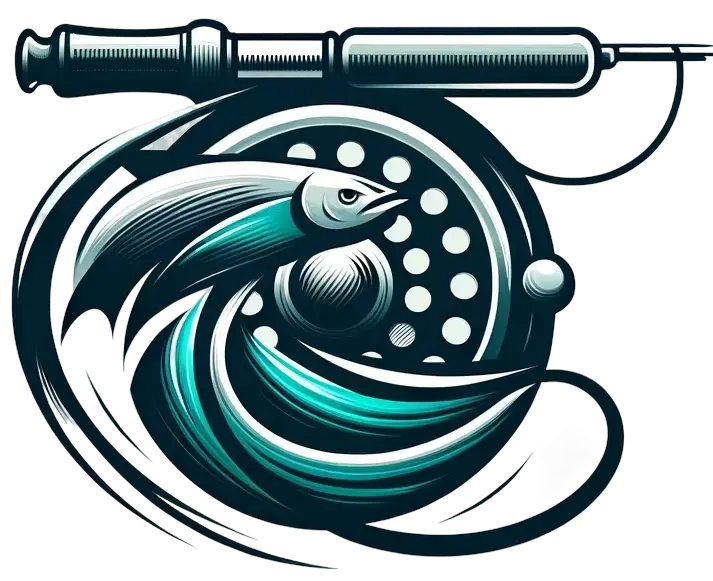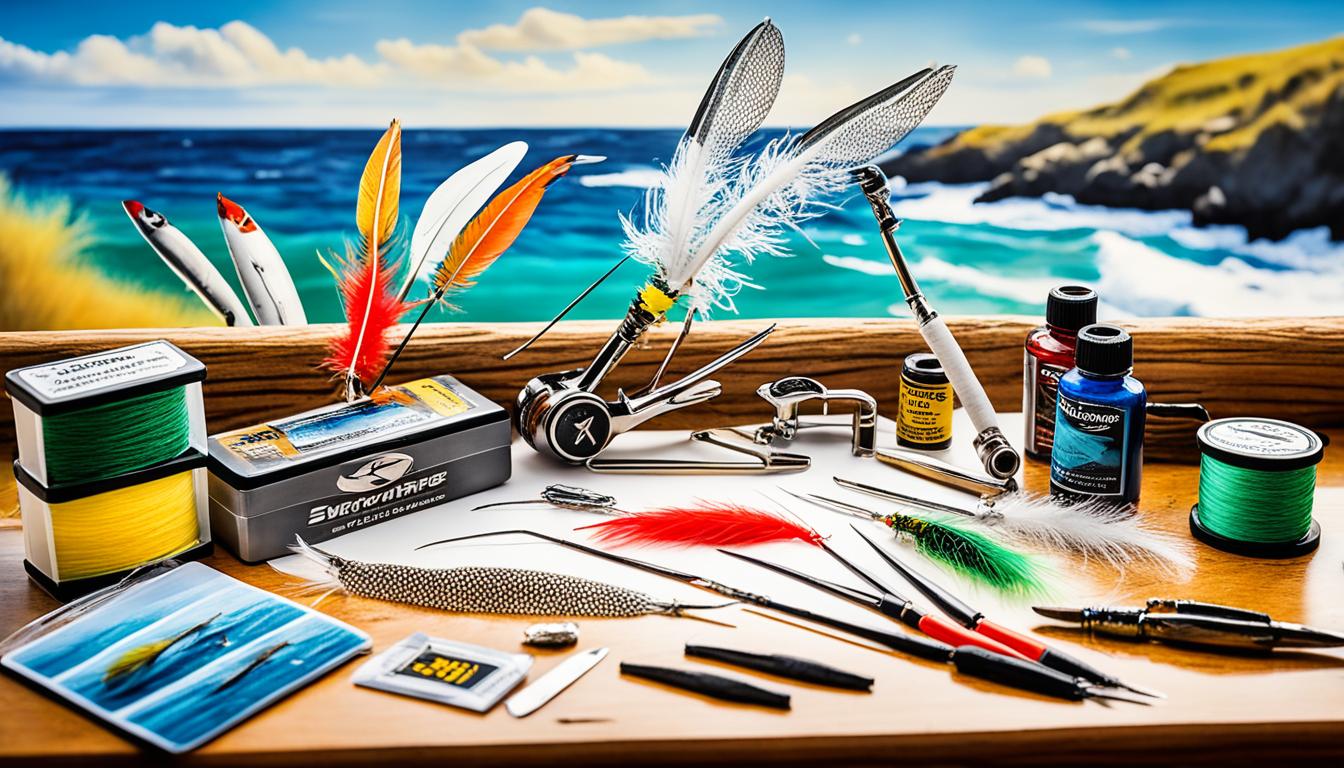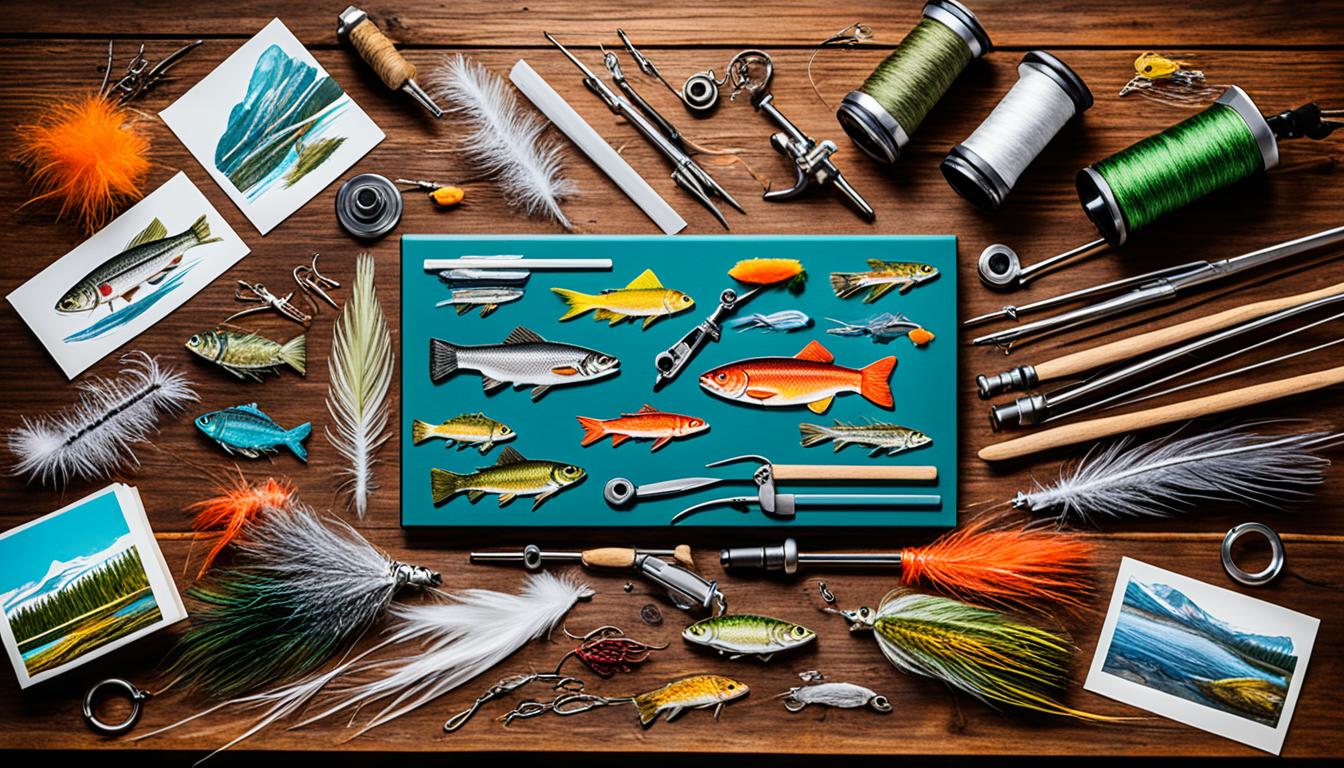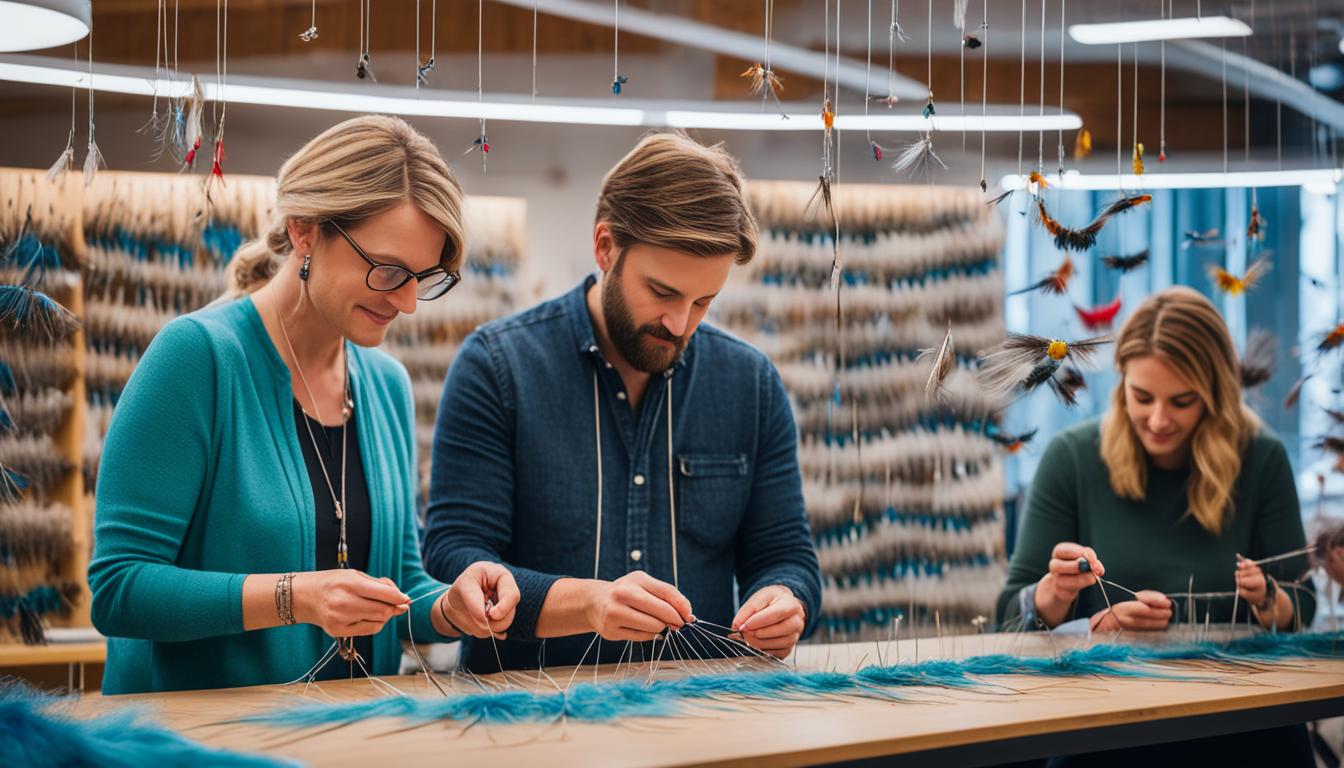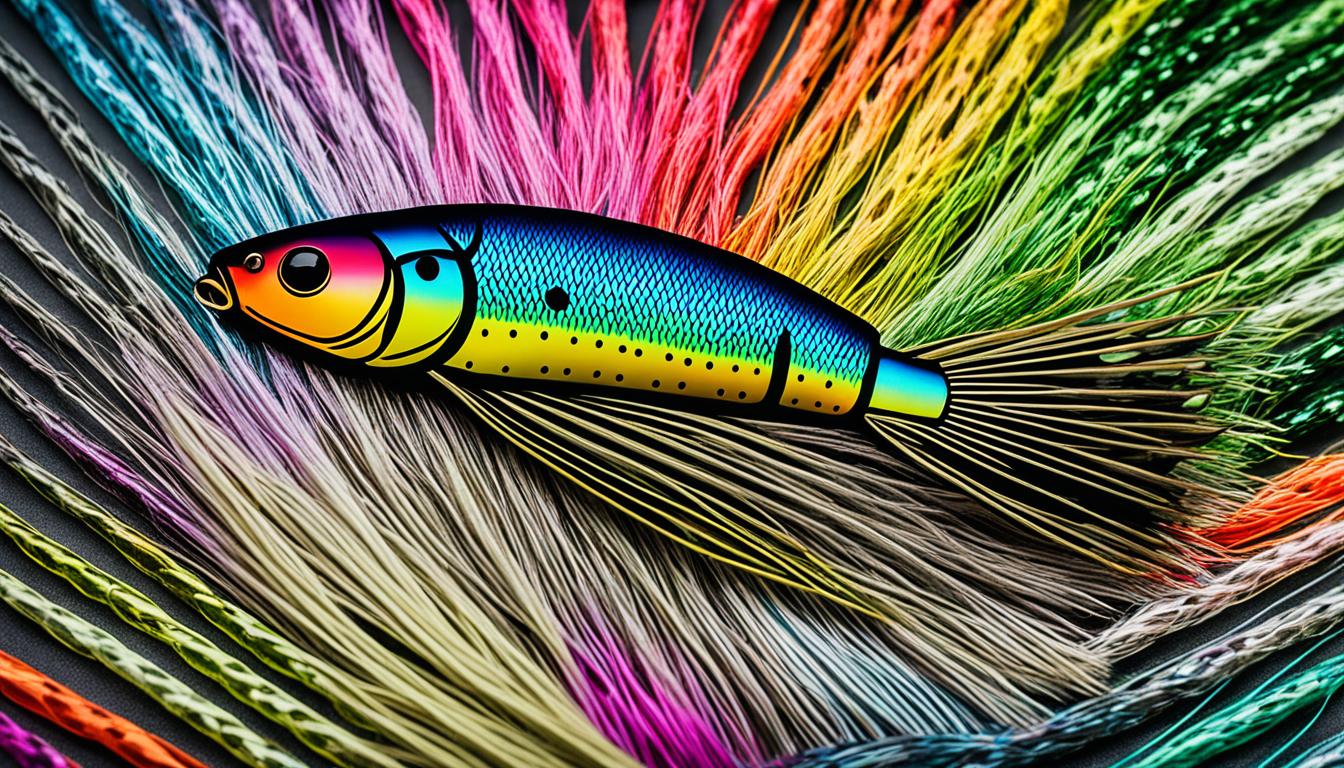Tying flies is not only a practical skill for anglers but also a creative outlet that allows us to craft effective imitations of natural prey. When it comes to saltwater fly tying, having the right tools, materials, and techniques is essential to creating flies that tempt and entice the fish. Whether you are just starting out or looking to refine your skills, this guide will provide you with the key essentials needed for successful saltwater fly tying.
Key Takeaways:
- Invest in high-quality fly tying supplies to ensure durability and success.
- Choose materials that mimic natural prey and provide lifelike movement in the water.
- Master essential fly tying techniques for saltwater patterns.
- Tailor your fly patterns to target specific saltwater species.
- Equip yourself with the right fly fishing gear to enhance your saltwater fly fishing experience.
Choosing Your Tools for Saltwater Fly Tying
When it comes to saltwater fly tying, having the right tools is crucial for achieving professional-quality results. From holding the hook securely to precise cutting, each tool plays a vital role in your fly tying process. Let’s explore the essential tools you need to elevate your saltwater fly tying game.
Fly Tying Vise
A fly tying vise is the cornerstone of every fly tyer’s toolkit. It securely holds the hook in place, allowing you to tie intricate patterns with ease. Look for a vise with adjustable jaws that can accommodate different hook sizes. A sturdy and well-built vise will ensure stability and precision throughout your tying process.
Fly Tying Lamp
A good fly tying lamp provides ample illumination, allowing you to see the fine details of your work. Opt for a lamp with adjustable brightness to create the perfect lighting conditions for your tying area. Proper lighting is essential for accurate color selection and precise execution of your fly patterns.
Scissors
Sharp and precise scissors are an indispensable tool for any fly tyer. They allow you to cleanly cut and trim various materials, ensuring neat and precise fly patterns. Look for scissors specifically designed for fly tying, as their fine tips and sharp blades enable intricate cuts with ease.
Bobbins
Bobbins are essential tools for managing and controlling your tying thread. They hold the thread spool and provide tension as you wrap the thread around the hook. Choose bobbins with ceramic or titanium inserts, as they reduce friction and allow for smooth thread flow, resulting in cleaner, more durable flies.
Pliers
Pliers are versatile tools that come in handy during fly tying. They are useful for flattening barbs on hooks, crimping materials, and handling small components. Look for pliers with a comfortable grip and fine tips for delicate work.
Fly Tying Tools
In addition to the core tools mentioned above, a range of fly tying tools can further enhance your efficiency and results. These tools include whip finishers, hackle pliers, bodkins, dubbing twisters, and more. Each tool serves a specific purpose and aids in creating intricate patterns with ease.
“Investing in high-quality tools is an investment in your fly tying success. By choosing the right tools, you can elevate your tying skills and create flies that truly stand out.”
With these essential tools at your disposal, you are well-equipped to embark on your saltwater fly tying journey. The right vise, lamp, scissors, bobbins, pliers, and other fly tying tools will not only improve your efficiency but also enhance the quality of your flies. Ready to take your saltwater fly tying to the next level? Let’s dive into the materials needed for crafting effective saltwater flies in the next section.
Beginner Fly Tying Materials for Saltwater Flies
When it comes to saltwater fly tying, the choice of materials is essential for creating effective and durable flies. Whether you’re a beginner or seasoned tyer, understanding the different options available is crucial. In this section, we’ll explore a variety of synthetic and natural materials, as well as flash materials, that are commonly used in saltwater fly tying.
Synthetic Materials:
Synthetic materials are favored by many saltwater fly tyers for their durability, vibrant colors, and versatility. These synthetic materials often closely imitate the appearance and movement of natural materials while providing added strength and longevity. Some popular synthetic materials for saltwater fly tying include:
- 1. Synthetic fibers, such as nylon and polypropylene, which can be used for creating streamer patterns that imitate baitfish and shrimp.
- 2. Synthetic dubbing, which can be used for creating bodies and thoraxes of saltwater flies.
- 3. Synthetic hair, like EP Fibers and Super Hair, which can be used for creating realistic baitfish patterns.
Natural Materials:
Natural materials add a lifelike quality to saltwater flies, providing realistic movement in the water. These materials are often sourced from birds, mammals, and reptiles. Some commonly used natural materials for saltwater fly tying include:
- 1. Feathers, such as marabou and hackles, which can be used to create wings, tails, and collars.
- 2. Fur, like rabbit and squirrel, which can be used for dubbing and winging materials.
Flash Materials:
Flash materials are an essential addition to saltwater flies, adding enticing sparkle and attracting attention from fish. These materials are typically incorporated as small accents or lateral lines. Some popular flash materials used in saltwater fly tying include:
- 1. Flashabou, which provides a reflective, shimmering effect.
- 2. Krystal Flash, a twisted mylar material that adds a vibrant flash to flies.
| Material | Use |
|---|---|
| Synthetic fibers | Creating baitfish and shrimp imitations |
| Synthetic dubbing | Building bodies and thoraxes |
| Synthetic hair | Designing realistic baitfish patterns |
| Feathers | Creating wings, tails, and collars |
| Fur | Using for dubbing and winging materials |
| Flashabou | Providing reflective, shimmering effect |
| Krystal Flash | Adding vibrant flash to flies |
Tying Tips for Saltwater Fly Tying Beginners
Are you new to saltwater fly tying or looking to improve your skills? Here are some valuable tips and tricks that will help you create effective saltwater fly patterns:
1. Master Thread Control: Thread control is crucial in fly tying. Practice maintaining tension and securing materials tightly without excessive thread wraps. This will ensure durability and tidy fly construction.
2. Secure Materials Properly: When tying saltwater flies, it’s important to secure materials firmly. Use plenty of thread wraps to prevent materials from coming loose during casting or while fighting fish.
3. Create Realistic Bodies: Realistic bodies are key to imitating natural saltwater prey. Experiment with different materials and techniques, such as dubbing, chenille, or epoxy, to create bodies that mimic the shape and texture of baitfish or shrimp.
4. Add Lifelike Movement: Saltwater flies should have lifelike movement in the water to entice fish to strike. Incorporate materials like marabou, hackles, or synthetic fibers that impart natural motion and give your flies a realistic appeal.
5. Experiment with Saltwater-Specific Techniques: Saltwater fly tying often requires specific techniques tailored to the behaviors of saltwater species. Scissor stacking, reverse tying, and using dumbbell or beadchain eyes are just a few examples. Explore these techniques to enhance your fly designs.
Quote:
Tying saltwater flies is an art that combines technical skill with creative expression. Embrace the learning process and don’t be afraid to experiment. With practice and perseverance, you’ll master the art of tying effective flies for the saltwater environment.
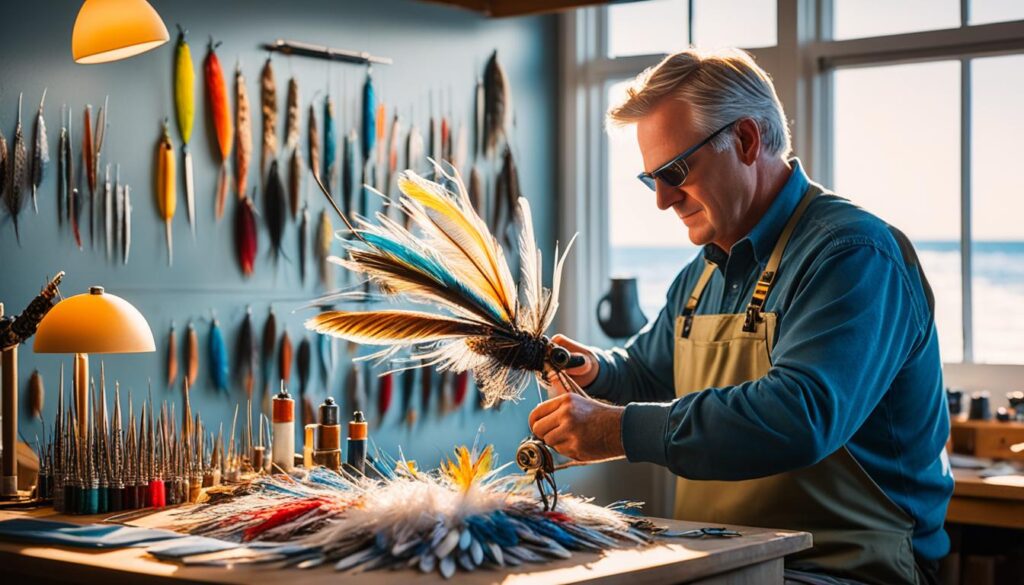
By following these tips, you’ll be on your way to creating successful saltwater fly patterns. Remember, practice makes perfect, so keep honing your skills and don’t hesitate to seek advice and inspiration from experienced tyers. Happy fly tying!
Choosing Saltwater Fly Patterns for Different Species
Different saltwater species have unique feeding habits and preferences, which require specific fly patterns to effectively imitate their natural prey. Whether you are targeting redfish, bonefish, permit, or tarpon, having the right fly patterns can greatly enhance your chances of success on the water. In this section, we will explore some popular saltwater fly patterns for these species and provide insights on their effectiveness.
Fly Patterns for Redfish
When targeting redfish, it’s important to have fly patterns that imitate the crustaceans and baitfish they commonly feed on. Here are a few effective redfish fly patterns:
- Gummy Minnow: This fly pattern mimics the appearance of small baitfish and is highly effective when redfish are actively chasing prey in shallow water.
- Kwan Fly: Designed specifically for redfish, the Kwan Fly imitates shrimp, one of their primary food sources. The combination of its lifelike movement and realistic coloration makes it irresistible to redfish.
Bonefish Flies
Bonefish are known for their skittish nature and keen eyesight. Therefore, your fly patterns need to be subtle and realistic. Here are a couple of proven bonefish flies:
- Crazy Charlie: The Crazy Charlie is a classic bonefish fly that imitates small shrimp. Its minimalistic design and subtle colors make it a go-to pattern for bonefish anglers.
- Gotcha: Another popular bonefish fly, the Gotcha imitates small shrimp or crabs. Its simple yet effective design entices bonefish to strike.
Permit Flies
Permit are notoriously picky eaters, making them one of the most challenging saltwater species to catch. To increase your chances, try using these permit fly patterns:
- Del’s Merkin: The Del’s Merkin is a crab fly pattern designed specifically for permit. Its realistic appearance and weighted body allow it to sink quickly, mimicking a crab in the water.
- Raghead Crab: This fly pattern imitates a small crab, which is one of the permit’s favorite prey items. Its lifelike movement and accurate coloration make it highly effective.
Tarpon Flies
Tarpon are voracious predators that feed primarily on baitfish. To entice a tarpon to strike, consider using these proven tarpon fly patterns:
- Black Death: The Black Death is a popular tarpon fly that imitates a variety of baitfish. Its dark silhouette and pulsating movement make it a tempting target for tarpon.
- Cockroach: The Cockroach fly pattern mimics a wounded baitfish, making it irresistible to tarpon. Its realistic coloration and lifelike movement make it a favorite choice for many tarpon anglers.
These are just a few examples of the countless saltwater fly patterns available for different species. The key is to match the fly pattern to the natural prey of the target species, taking into consideration their feeding habits and preferences. By selecting the right fly patterns, you can greatly increase your chances of success on your next saltwater fly fishing adventure.
Essential Saltwater Fly Tying Gear and Accessories
When it comes to saltwater fly fishing, having the right gear and accessories can make all the difference in your success on the water. In addition to your fly tying tools and materials, there are several key items you’ll need to ensure a productive and enjoyable fishing experience. From fly reels and lines to leaders and sunglasses, let’s explore the essential gear and accessories for saltwater fly fishing.
Fly Reels
A high-quality fly reel is a vital piece of equipment for saltwater fly fishing. Look for a reel with a strong drag system that can handle the powerful runs and bursts of speed that saltwater species are known for. Whether you’re targeting tarpon, bonefish, or redfish, a reliable fly reel will give you the confidence to land even the toughest fish.
| Brand | Model | Drag System | Price |
|---|---|---|---|
| Redington | Behemoth | Carbon Fiber | $129.99 |
| Lamson | Force SL Series II | Sealed Conical Drag | $429.99 |
| Orvis | Hydros SL | Carbon Fiber/Stainless Steel | $299.00 |
Fly Lines, Leaders, and Tippets
Choosing the right fly lines, leaders, and tippets is crucial for effectively presenting your flies to saltwater species. Opt for saltwater-specific fly lines that are designed to handle the harsh saltwater environment and cast large, wind-resistant flies. Leaders and tippets should be strong and abrasion-resistant to withstand the fish’s powerful runs and potential contact with sharp structures like coral heads or oyster bars.
Polarized Sunglasses
Polarized sunglasses are a must-have accessory for saltwater fly fishing. They not only protect your eyes from harmful UV rays but also reduce glare, allowing you to see beneath the water’s surface and spot fish more easily. Look for sunglasses with polarized lenses and a wrap-around design for maximum coverage and comfort.
Clothing
When it comes to clothing for saltwater fly fishing, comfort and sun protection are key. Choose lightweight, breathable fabrics that wick away moisture and provide UV protection. Consider long-sleeved shirts, pants, and sun gloves to shield your skin from the sun’s harmful rays. Don’t forget a wide-brimmed hat and a buff or neck gaiter to protect your face and neck.
Investing in high-quality gear and accessories will enhance your saltwater fly fishing experience and increase your chances of success on the water. With the right reel, lines, sunglasses, and clothing, you’ll be well-equipped to tackle the challenges of saltwater fly fishing and enjoy the thrill of hooking into your target species.
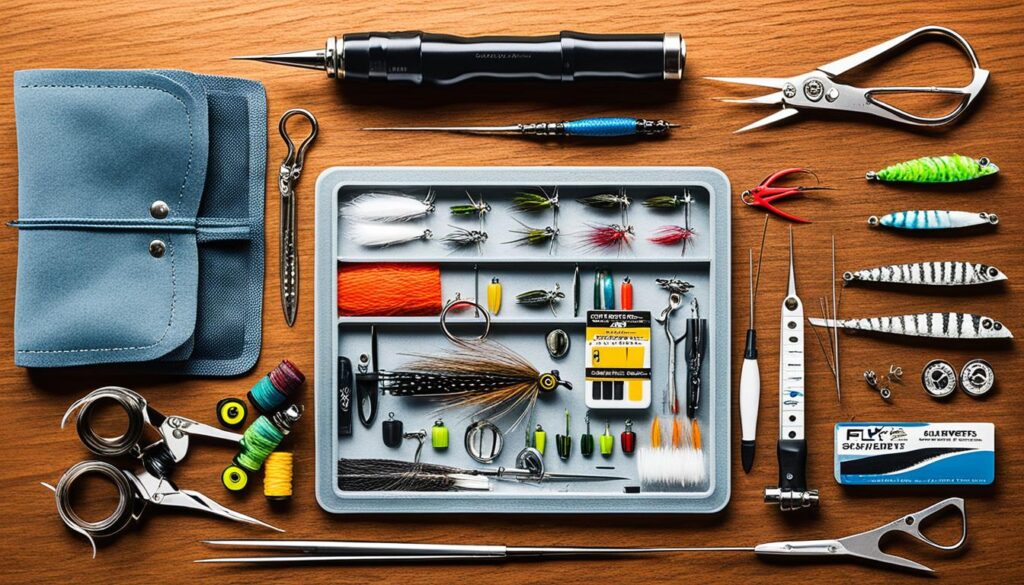
Conclusion
Tying saltwater flies is a rewarding and essential skill for any angler interested in pursuing saltwater fly fishing. By investing in the right tools, materials, and gear, and learning effective tying techniques, you can create flies that closely imitate the natural prey of saltwater species. Whether you are a beginner or an experienced tyer, this guide has provided valuable information on the essential elements of saltwater fly tying.
With practice and experimentation, you can develop your own successful patterns and enjoy the thrill of catching fish on flies you have tied yourself. The art of fly tying allows you to customize your patterns to match the specific conditions and species you are targeting. By understanding the behaviors and feeding habits of saltwater fish, you can create flies that trigger their predatory instincts and entice them to strike.
As you continue to refine your skills, don’t be afraid to try new materials, techniques, and patterns. The beauty of fly tying is in the endless possibilities it offers for creativity and innovation. By combining different materials and experimenting with various patterns, you may discover unique combinations that prove irresistible to saltwater fish. So, grab your tools and materials, dive into the world of saltwater fly tying, and unlock a whole new level of excitement and success in your fly fishing adventures.
FAQ
What are the essential tools needed for saltwater fly tying?
The essential tools for saltwater fly tying include a fly tying vise, fly tying lamp, sharp scissors, bobbins, pliers, and various fly tying tools. These tools help ensure precision and efficiency while tying flies.
What materials are commonly used for saltwater fly tying?
Saltwater fly tying materials can include synthetic materials for durability and vibrant colors, as well as natural materials like feathers and fur for lifelike movement in the water. Flash materials can also be used to add sparkle to your flies.
What techniques should beginners learn for saltwater fly tying?
Beginner saltwater fly tiers should focus on learning techniques such as thread control, securing materials, creating realistic bodies, and adding lifelike movement to their flies. These techniques will improve the effectiveness of their patterns.
What are some popular saltwater fly patterns for different species?
There are specific fly patterns for targeting different saltwater species. Popular patterns include redfish flies, bonefish flies, permit flies, and tarpon flies. Each pattern is designed to imitate the natural prey of the respective species.
What gear and accessories are essential for saltwater fly tying and fishing?
Essential gear and accessories for saltwater fly tying and fishing include a high-quality fly reel with a strong drag system, appropriate fly lines, leaders and tippets, polarized sunglasses for eye protection and improved visibility, and specialized clothing for comfort and sun protection.
What is the importance of saltwater fly tying?
Saltwater fly tying is an essential skill for anglers interested in pursuing saltwater fly fishing. By creating flies that closely imitate the natural prey of saltwater species, anglers can increase their chances of success and enjoy the thrill of catching fish on flies they have tied themselves.
